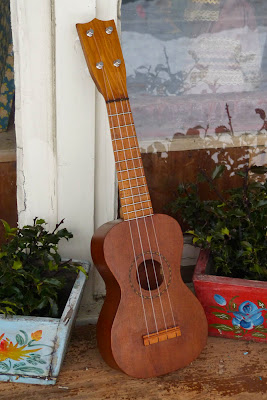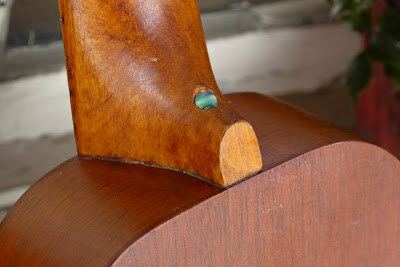c.1920 Regal-made Tonk Brothers Mahogany Soprano Uke
While branded "T.B. Co." in the soundhole, this uke is definitely of the usual earlier Regal-style build type that can be seen in fancier form in this uke (note headstock, heel style, and bridge) and also the simpler Red Head ukes. What that means is it's guaranteed a nice, sweet, rounded, "classic uke" tone from the get-go, as that's exactly what these old guys do. These Regals are built light and thin which makes them surprisingly full when compared to other period ukes side-to-side.
Work included a neck reglue (see details further down), bridge reglue, some seam repairs, a fret level/dress, new tuners, and setup. There's also a not-entirely-through hairline crack on the back that I drop-filled just for peace of mind. It plays nicely with 1/16" action at the 12th fret.
This uke has pretty plain-wrap mahogany for the back, sides, and top. The neck is poplar and the bridge appears to be as well. I do like that simple inlaid "rope" rosette, though! The top and sides are crack free.
12 nickel-silver frets. The necks on these have a slight v-shape to their rear but are a little wider (side to side) and thinner (front to back) in comparison to Oscar Schmidt and Harmony products from the same time. This makes them a little closer in style to the way a period Hawaiian uke performs in the hands.
The bridge had been previously reglued in the wrong place before -- just slightly off -- but I set the intonation when I reglued it and the scale runs to its proper 13 1/4" now. When I reglued the bridge I shaved it a bit from the bottom to improve action height.
This uke had a half-set of original wooden friction pegs. I've since replaced them with modern Saga-made "Golden Gate" friction pegs which are an especially nice product at the $10 they cost to install. They're very much similar to the fancier model $25 Grovers but at the same price point as the steadfast (and simple) Grover 2Bs.
The inset abalone dot hides a countersunk screw that I installed in the heel in addition to resetting the neck with glue. These ukes have a single dowel that holds the neck to the body and it's awkwardly-placed towards the upper end of the heel (nearer the fretboard) which means that no matter how nicely-glued the neck is, eventually it will "rock" on the center of the dowel joint like an old chair's dowel joints as glue ages and dries up at the lower part of the heel and comes loose.
I've anticipated this and installed a screw through the lower part of the heel which acts like a second "dowel" to stabilize against this issue. It should never have this problem (which is typical to this type of uke before work is done) develop going into the future.
There's the T.B. Co. mark (burned in). Tonk Brothers was a major distributor back in the day.
















Comments